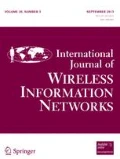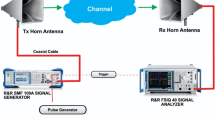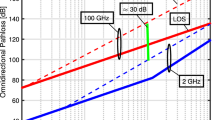Abstract
This paper proposes a model of radio frequency signal propagation in the free space that can be used not only in the far field region of the transmitting antenna like the Friis propagation model for large scale fading, but it can also be employed when the antennas are very close to each other. The modeling starts from a transfer function of the exact two-port network model used to represent the coupling between two antennas in free space. The Z parameter network of the system is used to model the power attenuation as function of the distance between the antennas. Subsequently, a new mathematical model is proposed and compared with the Z parameter network model and shown to have small mean squared error. Such model has the advantage of replacing the Friis formula without the restriction to avoid measuring signals in the near field of the antenna. Furthermore, some practical experiments are carried out in an open field environment and the results are compared. The validity of the new model is demonstrated which can be used for any distance between the antennas and, therefore, it can also be employed to model dense wireless networks.





Similar content being viewed by others
References
H. T. Friis, A note on a simple transmission formula, Proceedings of IRE, Vol. 34, No. 5, pp. 254–256, 1946.
M. Conti and S. Giordano, Mobile ad hoc networking: milestones, challenges, and new research directions, IEEE Communications Magazine, Vol. 52, No. 1, pp. 85–96, 2014.
P. Rawat, K. D. Singh, H. Chaouchi and J. M. Bonnin, Wireless sensor networks: a survey on recent developments and potential synergies, Journal of Supercomputing, Vol. 68, No. 1, pp. 1–48, 2014.
N. Heuveldop et al., Massive IoT Coverage in The City, Extract from The Ericsson Mobility Report, June 2017.
J. G. Andrews, H. Claussen, M. Dohler, S. Rangan and M. C. Reed, Femtocells: past, present, and future, IEEE/ACM Journal on Selected Areas in Communications, Vol. 30, No. 3, pp. 497–508, 2012.
S. Auroux, M. Draxler, A. Morelli and V. Mancuso. Dynamic network reconfiguration in wireless densenets with the crowd SDN architecture. In Proceedings of European Conference on Networks and Communications (EuCNC), pages 144–148, Paris, France, 2015.
O. Dousse, F. Baccelli and P. Thiran, Impact of interferences on connectivity in ad hoc networks, IEEE Transactions on Networks, Vol. 13, No. 2, pp. 425–436, 2005.
O. Arpacioglu and Z.J. Haas. On the scalability and capacity of wireless networks with omnidirectional antennas. In Proceedings of IEEE International Conference on Information Processing in Sensor Networks (IPSN), pages 169–177, New York, NY, USA, 2004.
L.R. de Paula and R.M. de Moraes. Channel capacity in dense MANETs for a propagation model considering the law of conservation of energy and fading. In Proceedings of IEEE Wireless Communications and Networking Conference (WCNC), pages 2424–2428, Paris, France, 2012.
P.C. Ghobad and R.M. de Moraes. BER analysis with an appropriate Friis formula for multi-hop aloha dense ad hoc networks. In Proceedings of IEEE Vehicular Technology Conference (VTC Fall), pages 1–5, Quebec, Canada, 2012.
T. S. Rappaport, Wireless Communications: Principles and Practice, Prentice HallNew York, 2002.
A. Goldsmith, Wireless Communications, Cambridge University PressCambridge, 2005.
T. S. Rappaport, Y. Xing, G. R. MacCartney Jr., A. F. Molisch, E. Mellios and J. Zhang, Overview of millimeter wave communications for fifth-generation (5G) wireless networks-with a focus on propagation models, IEEE Transactions on Antennas and Propagation, Vol. 65, No. 12, pp. 6213–6230, 2017.
G. R. MacCartney and T. S. Rappaport, Rural macrocell path loss models for millimeter wave wireless communications, IEEE Journal on Selected Areas in Communications, Vol. 35, No. 7, pp. 1663–1677, 2017.
W. Viriyasitavat, M. Boban, H.-M. Tsai and A. V. Vasilakos, Vehicular communications: survey and challenges of channel and propagation models, IEEE Vehicular Technology Magazine, Vol. 10, No. 2, pp. 55–66, 2015.
T. Stoyanova, F. Kerasiotis, A. Prayati, G. Papadopoulos. A practical RF propagation model for wireless network sensors. In Proceedings of International Conference on Sensor Technologies and Applications (SENSORCOMM), Athens, GlyfadaGreece, 2009. pp. 194–199.
K. M. Yusof, J. Woods and S. Fitz. Short-range and near ground propagation model for wireless sensor networks. In Proceedings of IEEE Student Conference on Research and Development (SCOReD), pages 124–128, Pulau Pinang, Malaysia, 2012.
J. Alshudukhi, S. Ou and P. Ball. A ground level radio propagation model for road-based wireless sensor networks. In Proceedings of International Symposium on Communication Systems, Networks & Digital Sign (CSNDSP), pages 146–151, Manchester, UK, 2014.
D. B. Smith, D. Miniutti, T. A. Lamahewa and L. W. Hanlen, Propagation models for body-area networks: a survey and new outlook, IEEE Antennas and Propagation Magazine, Vol. 55, No. 5, pp. 97–117, 2013.
S. Panichpapiboon, G. Ferrari and O. K. Tonguz. Sensor networks with random versus uniform topology: MAC and interference considerations. In Proceedings of IEEE Vehicular Technology Conference (VTC Spring), pages 2111–2115, Milan, Italy, 2004.
O. K. Tonguz and G. Ferrari, Ad Hoc Wireless Networks: A Communication-Theoretic Perspective, WileyHoboken, 2006.
T. Prakoso, R. Ngah, Z. Ghassemlooy and T. A. Rahman, Antenna representation in two-port network scattering parameter, Microwave Optical Technology Letters, Vol. 53, No. 6, pp. 1404–1409, 2011.
P.V. Nikitin, K.V.S. Rao and S. Lazar. An overview of near field UHF RFID. In Proceedings of the 1st IEEE International Conference on RFID, pages 167–174, Grapevine, TX, USA, 2007.
S. J. Orfanidis, Electromagnetic Waves and Antennas, Rutgers UnivNew Brunswick, 2008.
A. R. Conn, N. I. M. Gould and P. L. Toint, Trust Region Methods, SIAMPhiladelphia, 2000.
CC1101 and CC1201, Radio Module Datasheets. Texas Instruments, 2015.
Acknowledgements
This work was supported by CNPq, Brazil.
Author information
Authors and Affiliations
Corresponding author
Additional information
Publisher's Note
Springer Nature remains neutral with regard to jurisdictional claims in published maps and institutional affiliations
Rights and permissions
About this article
Cite this article
de Moraes, R.M., de Almeida, I.P. & Menezes, L.R.A.X. A Radio Propagation Model for Dense Wireless Networks. Int J Wireless Inf Networks 26, 90–95 (2019). https://doi.org/10.1007/s10776-019-00424-z
Received:
Accepted:
Published:
Issue Date:
DOI: https://doi.org/10.1007/s10776-019-00424-z




